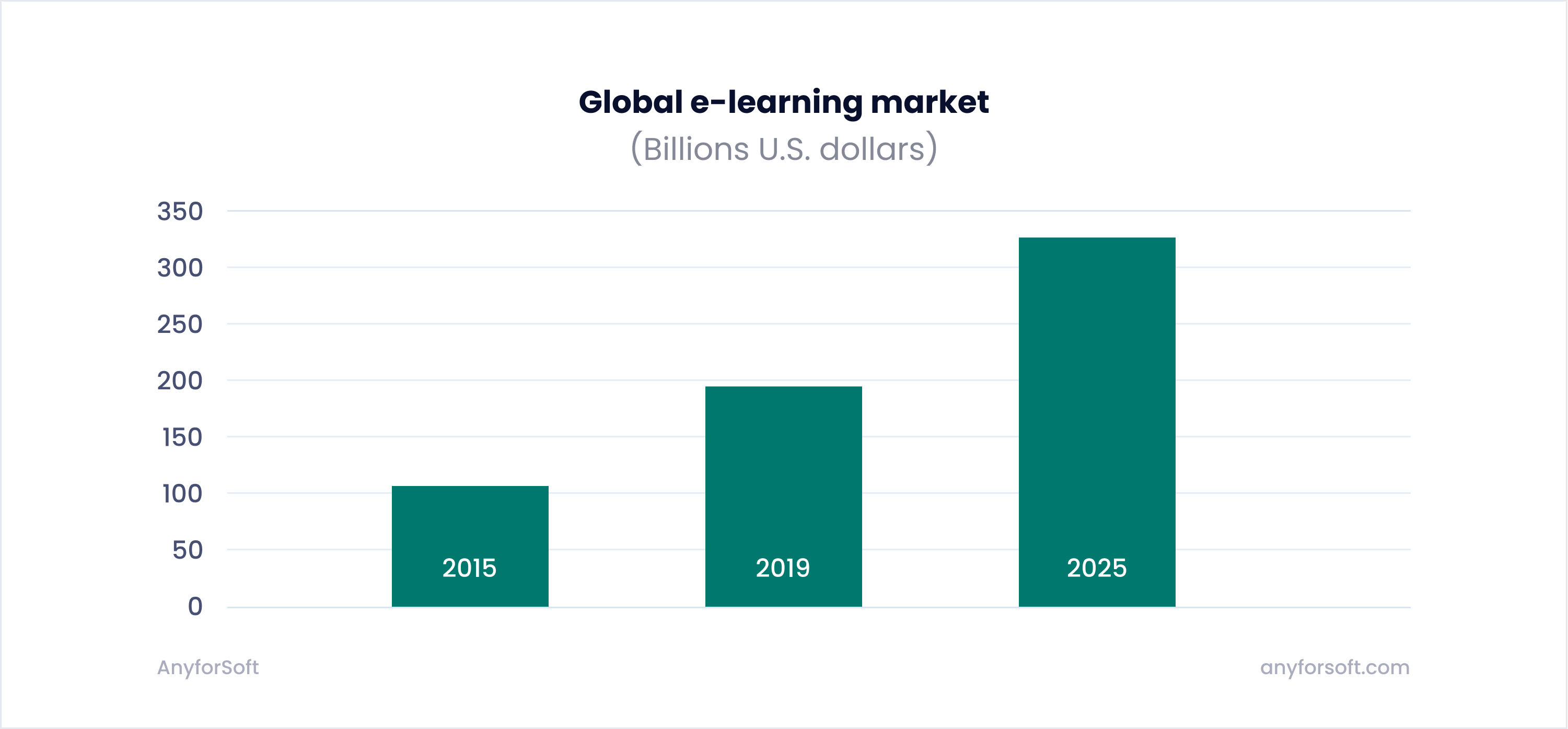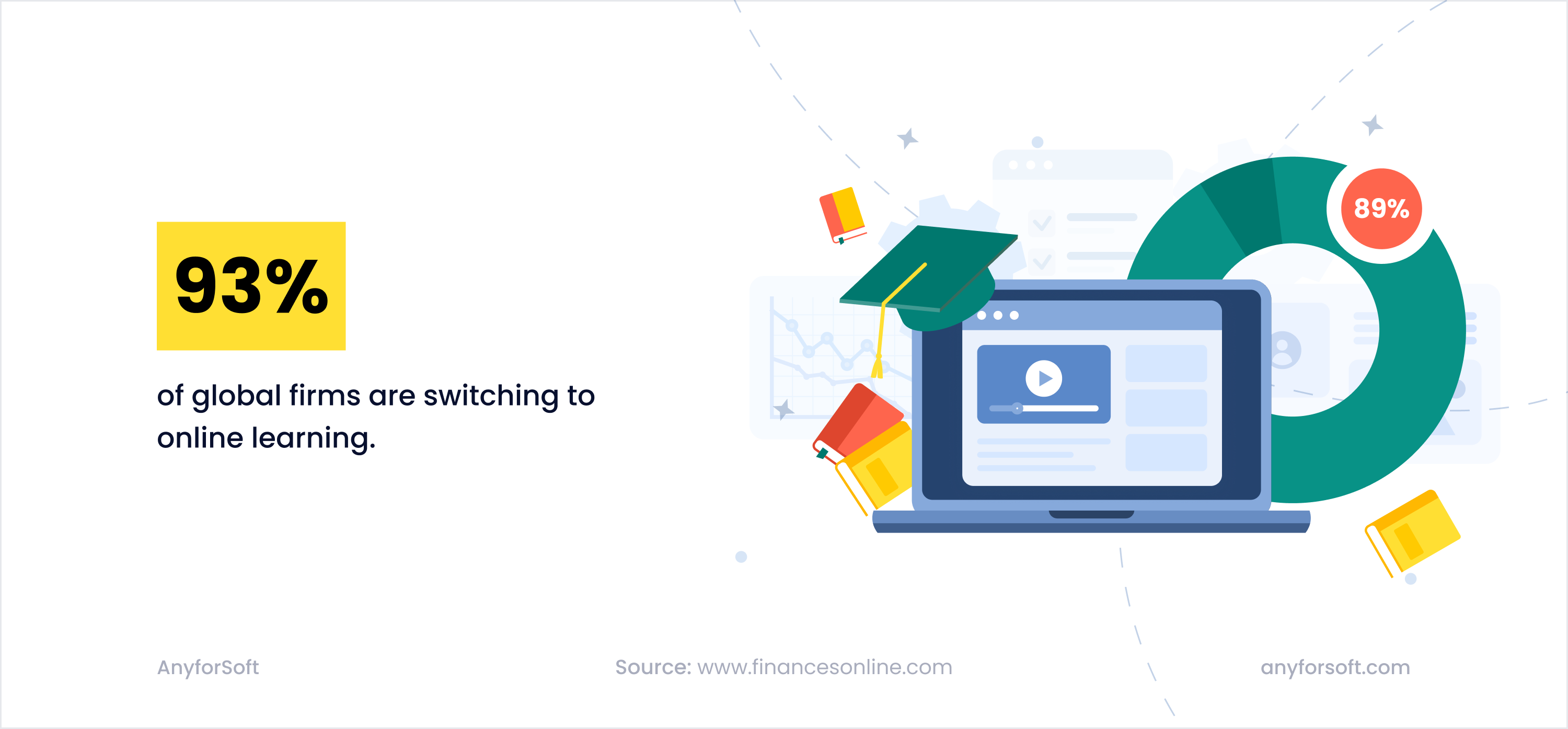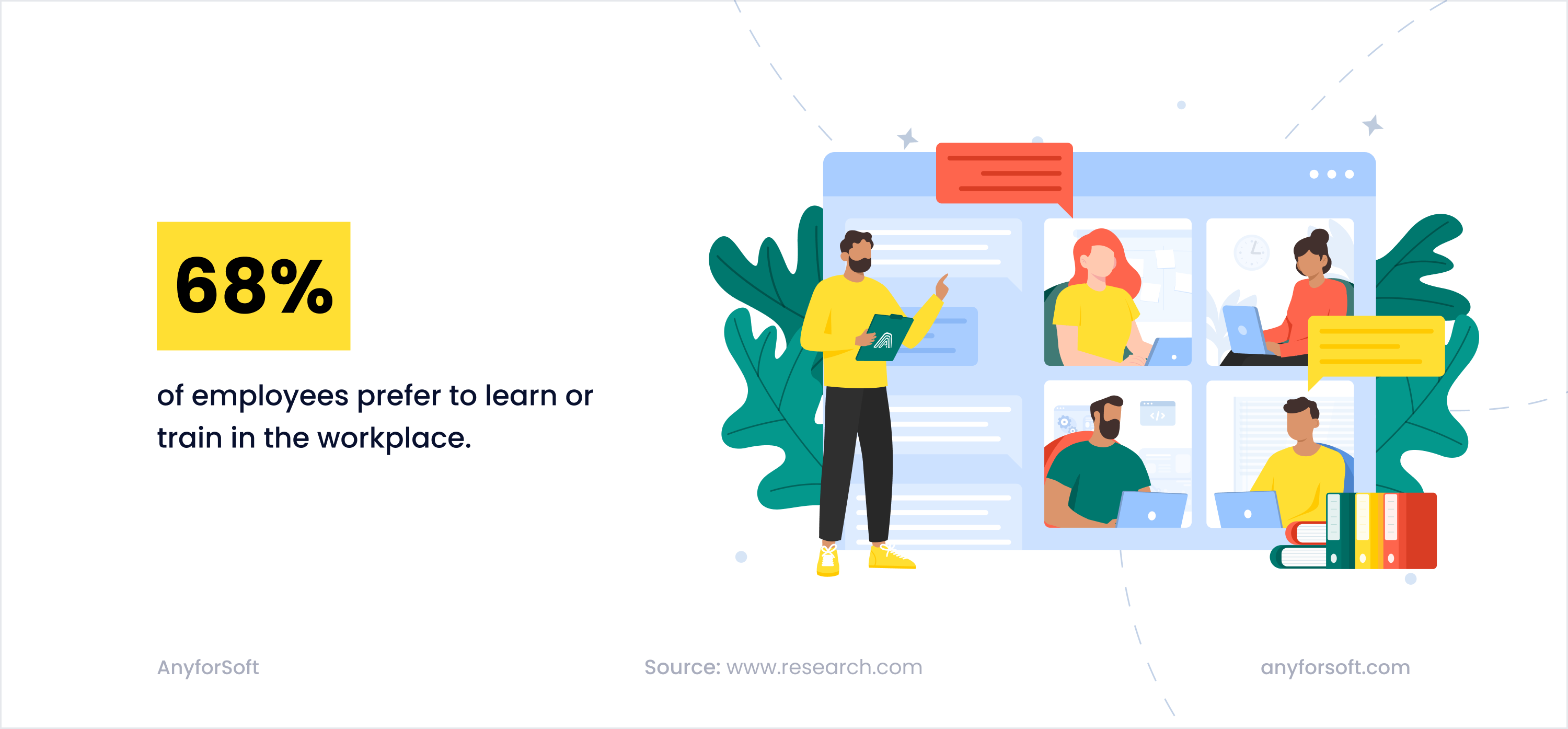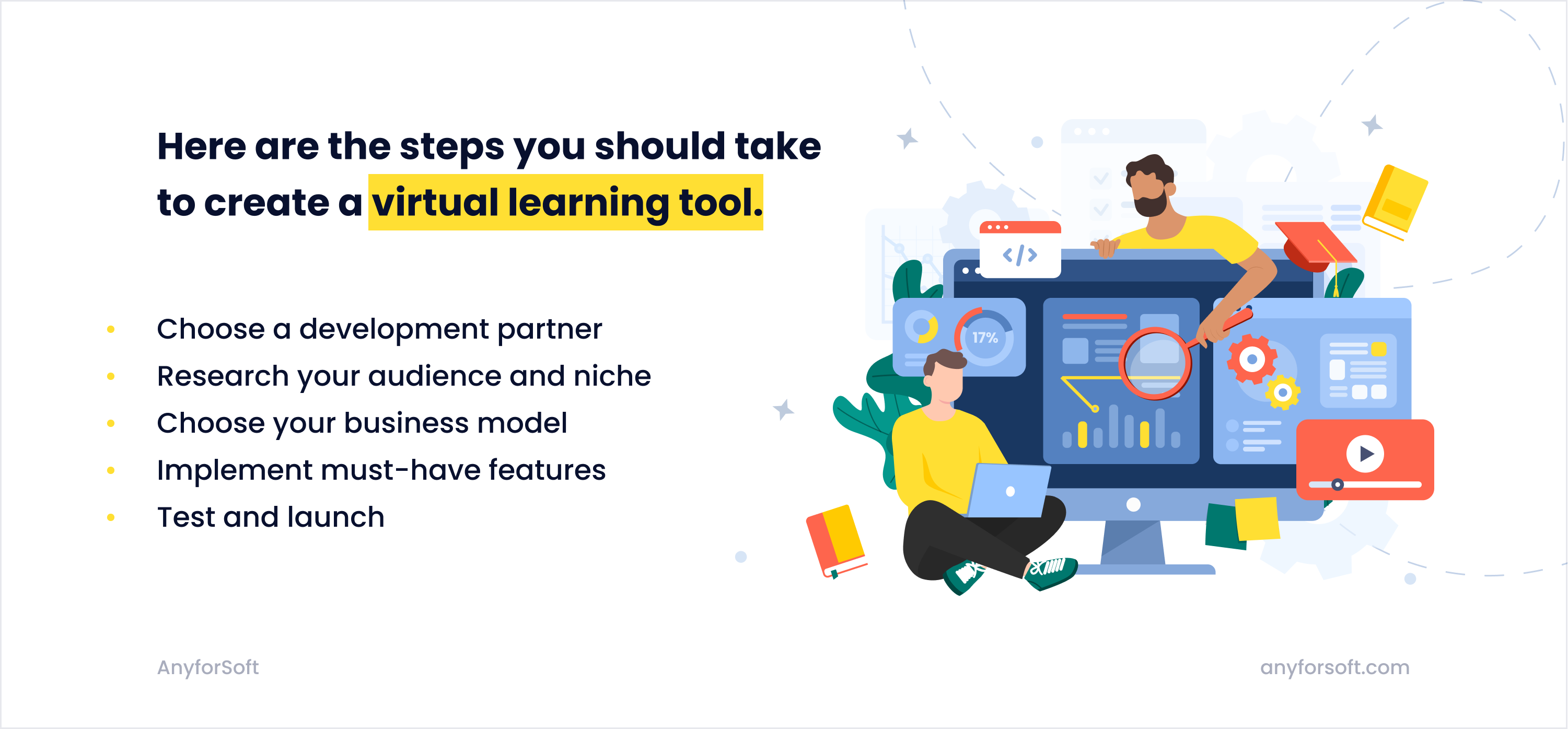In the past two and a half years, the COVID-19 pandemic has negatively affected the entire educational system. Schools, colleges, and universities worldwide have been closing their doors to prevent the spread of the virus. Luckily, modern technologies enable us to study remotely, so it’s only natural that students and teachers are adopting elearning platforms that offer comprehensive elearning content.
That gives tremendous growth to the already colossal e-learning industry.
Just think about it: since 2000, it has expanded by a whopping 900%! All indicates that it will continue snowballing: TechJury predicts the market will reach the $325 billion mark by 2025.

Want to get your bar of gold from this multi-billion goldmine?
Then you should definitely consider educational portal development with robust education capabilities.
By developing your own user-friendly platform or mobile application, you can target learners all over the world, without geographical restrictions.
But first, you need to know how to create your tool and what features to develop. And that’s exactly what we are going to discuss in the following paragraphs.
As an e-learning software development company, AnyforSoft is here to share insights on the global e-learning market. Our company builds development teams that care about your vision and create high-quality products that meet your requirements and expectations. We also share our expertise in this blog, giving away valuable information to help you transform your idea into a successful project.
In this particular article, you will find answers to the following questions:
- What types of educational tools can you build?
- How to create an e-learning platform from scratch?
- What are the key benefits of an e-learning system?
- What features should an e-learning website or app have to be successful?
- What are the current trends in the e-learning industry?
Without further ado, let’s get down to business.

Types of online learning platforms you can create
There are many types of online education platforms you can build. The most common are: Learning management systems. Massive Open Online Courses (MOOCs). Custom platforms.
Let’s discuss each type in more detail.
Learning management systems
A learning management system (or LMS for short) is software with basic functionality that allows for creating, conducting, and hosting e-learning content. Using these systems, tutors can store and manage courses, assess learner’s performance, monitor their participation, and more.
Most LMSes are web-based applications. They have everything needed to cater to the needs of modern educational institutes and companies that conduct employee training outside the traditional classroom. They enable you to:
- Create your own courses with gamification features.
- Integrate social media education tools.
- Leverage various types of learning and more.
If you’re looking to develop a tutoring-focused solution, consider tutor app development to create a seamless experience for educators and students alike.
Learning experience platforms
A learning experience platform (LXP) is software that delivers a personalized learning experience and helps students discover new opportunities that come far beyond traditional education. It combines learning materials from various sources and recommends them to users with the help of Artificial Intelligence (AI). This helps in creating unique learning pathways.
With AI becoming a key driver of innovation in education, leveraging AI for education can enhance personalization, automate administrative tasks, and improve learning outcomes.
You can also check a comprehensive comparison of LXP vs. LMS and find out how to make the best choice for your particular purposes.
Massive Open Online Courses (MOOCs)
MOOCs are courses with open access aimed at unlimited participation. They offer participants various learning materials, often similar to those used in conventional online education settings (videos, lectures, problem sets, etc.) and options (individual training programs for each student, video conferencing, virtual learning opportunities, etc.). Many MOOCs provide interactive courses with access to user forums and social media discussions to engage learners, educators, and teaching assistants in community interactions.
Custom platforms
If you aim to create your own e-learning platform that doesn’t fit any of the types described above, you can opt for a custom solution. AnyforSoft will build an expert team that will develop an e-learning website or mobile application following your business requirements and needs. We will pay attention to your business peculiarities, the type of your company, and a portrait of learners. That will allow us to create a solution that will be of value to customers.
Additionally, if your target audience includes universities and colleges, investing in higher education website design can ensure an intuitive and accessible experience for students and faculty.

Course Marketplace platforms
These platforms work similarly to Amazon or eBay, but for eLearning content. Instructors can upload and sell their courses, and students can view and purchase them. For this type of platform, it is important to have robust integration capabilities with popular payment gateways. They usually have extensive integration capabilities with various payment systems and content delivery networks. Additionally, these platforms offer interactive quizzes, discussion boards, and collaboration tools to engage learners.
Virtual Classrooms
Online spaces that replicate traditional classrooms with live video sessions, real-time communication, and interactive whiteboards. They often feature interactive quizzes, collaboration tools like shared whiteboards, and breakout rooms, as well as discussion boards for asynchronous communication.
Corporate Training Platforms
Designed for businesses to deliver compliance training, employee upskilling, and professional development courses. They include integration capabilities with HR systems and performance-tracking tools to monitor a learner’s performance.
K-12 and Higher Education LMS
Platforms customized for schools and universities, supporting blended learning models with features such as a notification system, customization options, and comprehensive assessment tools.
What Influences E-learning Platform Development Cost?
1. Platform complexity
- Basic vs. advanced feature sets
- Integration capabilities with third-party tools
- Complexity of elearning content management
- Scalability requirements
2. Design and User Experience (UX)
- User-friendly interface development
- Mobile responsiveness
- Interactive elements implementation
- Custom UI/UX design
3. Technical requirements
- Backend infrastructure
- Data protection measures
- Server configuration
- Learning platform’s performance optimization
4. Content features
- Interactive quizzes development
- Discussion boards implementation
- Collaboration tools integration
- Content delivery system
5. Customization and scalability
- Customization options scope
- Growth accommodation
- Performance optimization
- System scalability
The development costs typically range from $25,000 for basic platforms to $100,000+ for advanced solutions with comprehensive features.
How long does it take to create an e-learning platform?
The time required to build an e-learning platform can vary based on several factors. The complexity of the platform, the desired features and functionalities, the size of the development team, and the availability of resources can all influence the development timeline.
Benefits of building an online learning platform
Before we dive deep into describing how to build learning platform’s solution, let’s discuss why you should do it in the first place. Here are the top benefits of developing your own educational website or mobile application:
- 24/7 availability. Unlike physical educational institutions, e-learning platforms are available round the clock, allowing students to access learning materials whenever they want.
- No geo-restrictions. With your own e-learning platform, you will be able to target users all over the world without any geographical restrictions.
- Time efficiency for students. Studies show that learning online usually requires from 40% to 60% less time investment from a student than traditional learning.
- Higher retention rates. Various sources say online learning platforms retain students more effectively than traditional classrooms.
How to build an e-learning platform

Online learning platform development is a complex process that requires significant time and resource investments.
Here are the steps you should take to create a quality e-learning product.
#1 Choose a development partner
You can create a virtual learning platform with your in-house team, outsource this task to a third-party developer, or hire freelancers.
Let’s discuss the advantages and disadvantages of each option.
In-house team
Having an in-house team for developing e-learning platforms is excellent because it gives you direct control of the project, allowing you to make any changes swiftly. Instead of contacting someone and waiting for a response, you can call a meeting with your teammates and discuss development matters in person.
However, an in-house team is pretty expensive. Instead of making a one-time payment to an e-learning app development agency or freelancers, you will need to pay a monthly salary to each worker. Besides, a talent pool is limited to your region — who knows, it might be challenging to find talented developers there.
Development company
Outsourcing your project to a third-party developer is cost and time efficient. You won’t have to worry about recruiting developers and then paying them a salary. Plus, the talent pool is not limited — you’re free to choose any company whose expertise you trust.
As for the downsides, with third-party developers, you don’t have direct control over your project. In addition to that, you might experience communication issues, especially if the company you hired is at a different timezone.
But don’t worry — it won’t happen if you choose new.anyforsoft We assign a competent project manager to each customer to keep them informed of any events regarding their projects. Plus, we are available anytime, so you can contact us whenever you need.
Freelancers
Hiring freelancers is the cheapest option of all. Freelance portals allow you to set your own price for the services you need: that way, you can find people who will agree to develop your e-learning app on your terms.
However, be careful:
- There are many non-professionals among freelancers, especially in the budget segment. Thus, if you want to create a complicated e-learning platform with advanced features like VR or augmented reality, you better choose another option.
- Also, hiring freelancers is risky. You might run into a scammer who will take the money but not do the job properly or, what’s worse, steal your data.
That’s why we advise either developing an e-learning tool with your own team or outsourcing it to a reliable development agency instead of hiring freelancers. But if your budget is too limited, going to freelance platforms might be the only viable option.
#2 Research your audience and niche
If you want your project to be successful, start e-learning software development with the discovery phase. Basically, it is market research that will allow you to find your target audience and reveal their needs and pain points to develop your solution accordingly.
Four specialists typically conduct the discovery phase:
- Business analyst — analyzes the market and considers possible ways to satisfy the needs of a target audience.
- Software architect — studies the initial technical requirements and suggests tools to use in development.
- Project manager — ensures communication between the team and the client.
- UI/UX designer — analyzes which design practices work best for a particular type of e-learning platform by conducting competitor research.
The discovery phase helps prevent budget overruns, scope creep, and missed deadlines. By the end of it, you will receive the development cost estimation and other deliverables: user proto persona, project roadmap, product wireframes, business model canvas, and more. All of it will help you thoroughly plan the entire project.
#3 Choose your business model
Once you know your audience and understand their needs, you have to decide on your business model. It will define how your virtual learning platform will generate revenue. Here are the most common business models:
Subscription-based model
A subscription-based model is a model in which learners pay a weekly, monthly, or yearly fee in exchange for the online courses you provide.
Pros:
- Easy to implement.
- Steady source of revenue.
- Attractive for students, provided that you offer affordable subscription fees.
Cons:
- High churn rates: users can unsubscribe at any time.
- To secure a decent income, a large user base is needed.
Pay-per-course model
This model is pretty straightforward: you, as a tutor, decide a price for your online learning courses, and students pay you to receive access to them.
Pros:
- Convenient for learners, as they can pay only for courses they need.
- This model allows for easy upselling: you can bundle together courses on the same topic and offer them to students.
- You can set an individual price for each paid course based on its value, which is impossible with the subscription-based model.
Cons:
- No recurring payments: regular course creation is needed to stabilize your income.
Combined model
As the name suggests, this model is a combination of the pay-per-course model and the subscription-based model. If you choose to create an online learning platform with the combined model, you will be able to sell your courses individually and provide them on a subscription basis. You can also divide your learning materials into two groups: those available only for sale and those available by subscription.
#4 Decide on core technologies
Just as a master chef carefully selects ingredients and builds layers of flavors to create a memorable dish, developing a digital platform requires a thoughtful selection of technological components. Like combining spices and base ingredients that complement each other perfectly, choosing the right tech stack forms the recipe for your e-learning platform’s success. Each technology you select is like a crucial ingredient – some provide the fundamental structure, others add functionality, and together they create a seamless digital experience.
So, what technologies are commonly used to develop e-learning platforms? Common tech stack used to develop collaborative e-learning platforms include programming languages such as Python, Ruby, or PHP; web frameworks like Django or Ruby on Rails, content management systems (CMS) such as WordPress or Moodle, learning management systems (LMS); and databases like MySQL or PostgreSQL.
#5 Implement must-have features
When everything above is done, it’s time to start the development process. Here is the list of essential features to consider in educational platform development. We divided them into three categories: student profile features, teacher profile features, and admin panel features.
Note: the features may vary depending on the types of e-learning platforms you want to build.
Student profile features
- Add a search engine to enable users to find courses by keywords.
- Add filtering functions so learners can filter courses by price, subject, duration, teacher, expertise level, and other parameters.
- Develop recommendation algorithms to provide users with the educational content they are most interested in. You can base recommendations on the courses the users already signed up for.
- Add payment systems. Student profiles must be integrated with payment options to ensure transaction security.
Teacher profile features
- Develop course creation and editing functionality to enable tutors to create their own courses.
- Design a dashboard to help course creators keep track of the uploaded courses and see the number of participants, the amount of money they made, etc.
- Add a withdrawal function so that tutors can withdraw the money they made on the online educational platform.
Admin panel features
- Add a function to add and remove users.
- Add a function to add and delete courses.
- Add functionality for organizing, managing, monitoring, and reporting course activities.
- Develop notification system management features.
Talking about must-have features you should consider, we also want to mention something very important: multimedia elements. If you want your eLearning portal to stand out among the best, integrating multimedia elements such as video content, images, audio files, and interactive content is a common feature of e-learning websites. Make sure your platform has a responsive design before implementing all of that. You can use virtual classroom software, video streaming services, and multimedia player libraries to embed and deliver multimedia content effectively.
#6 Think of security
Security is a must, we all know that. Especially at a time when personal data breaches are as common as people flying into space. To ensure the security of your e-learning website, you should implement secure user authentication and authorization mechanisms, use encryption for sensitive data, regularly update and patch your software, conduct security audits, and adhere to best practices for secure coding.
Additionally, consider implementing secure hosting environments, firewall protection, and robust backup and disaster recovery systems.
#7 Test and launch
Once you create an e-learning platform, don’t rush to release it. Before launch, you should ensure that every feature you’ve implemented works properly. To do that, you need an experienced QA engineer. Different testing techniques (both manual and automated) allow finding most issues users might face while interacting with your e-learning tool. Your goal is to eliminate as many bugs as possible before the release. If you fail to do so, you will spoil the learning journey for your customers, resulting in lower retention rates and revenue.
Thus, don’t neglect QA testing if you aim to provide a good UX.
Also, consider following these trends to make your online learning tool even better.

Current trends in e-learning
Learning through playing a game is arguably one of the easiest ways of learning, especially for children. Let’s face it—most kids don’t like to study, but they do like to play. No wonder so many learning platforms have various elements of gamification.
Gamification
Learning through playing a game is arguably one of the easiest ways of learning, especially for children. Let’s face it — most kids don’t like to study, but they do like to play. No wonder so many online learning platforms have various elements of gamification.
Take Quizlet, for example.
Quizlet is an e-learning app developed to help students study information through interactive tools and games. It allows teachers to create learning materials that users can then study in the most convenient way for them. For instance, they can learn foreign words by playing a matching game in which they match new terms with their definitions.
Building an e-learning platform with gamification elements is a great way to help students learn new information more effectively. Researches show those who study through gamified systems perform better on tests than those using more conservative learning methods. It applies to both children and adults.
Therefore, consider adding gamification features to your online learning platform — it will help not only effectively educate your users but also engage them and deliver a better user experience.

Artificial Intelligence (AI)
AI has become a regular part of our daily lives. Gradually, it reached the e-learning website development industry. Today’s most advanced educational platforms use AI algorithms that allow for developing top-notch functionality.
Duolingo is one of the most prominent examples of artificial intelligence used in the e-learning industry. Duolingo is a language learning platform that enables users to improve vocabulary, grammar, listening, and pronunciation skills in a foreign language. It also provides certification.
The company has been open about the research behind its application: the fact that they apply machine learning is actually a part of its branding.
But how exactly does artificial intelligence help Duolingo deliver a better user experience?
Firstly, Duolingo uses AI (Duolingo’s Birdbrain model) to personalize its online courses. Based on a learner’s strengths, weaknesses, and personal learning preferences, the platform offers courses that are the most appropriate for them at a specific moment. The algorithm pays attention to the learner’s vocabulary, grammar skills, and the types of learning content they enjoy the most.
Duolingo’s AI also uses natural language processing (NLP) systems to create interactive chatbots for learners to practice their conversational skills.
All of that helps the company engage users and educate them more effectively.
Video-based Approach
Videos have been used heavily in massive open online courses. We have all the reasons to believe it will continue to be so, as information in video content is easier to consume than those in text content. According to Wyzowl, 69% of users prefer watching videos over reading articles. Thus, if you want your online learning platform to offer a smoother learning process, consider adding video material to your courses.
Monetization
Monetization is now one of the main trends you can hear about in the digital world. As experts in this field, we know that you can monetize your eLearning platform. How? There are several ways. You can offer paid courses or subscriptions, provide premium content or features, partner with other educational institutions or organizations, offer certifications or assessments for a fee, or implement advertising or sponsorship opportunities.
Cost Of E-Learning Platform Development
Developing an e-learning website can vary in cost depending on several factors. The complexity and scale of the website, as well as the features and functionalities you want to include, will play a significant role in determining the overall cost. Additionally, the development approach and the expertise of the developers involved impact it as well.
On average, the cost of an e-learning platform development can range from $20,000 (basic e-learning websites) to $100,000 (virtual education platforms with extended functionality) or more. This cost typically covers various aspects of the e-learning development process, such as designing the user interface (UI) and user experience (UX), creating the backend infrastructure, implementing features like course management, progress tracking, assessments, and multimedia integration, as well as ensuring compatibility across different mobile devices and platforms.
It’s important to note that the cost can increase further if you require additional customizations, integrations with third-party tools or systems, or the development of mobile applications alongside the web platform. Ongoing maintenance, updates, and hosting expenses should also be considered.
To optimize e-learning platform development costs, some organizations opt for using pre-built e-learning websites or LMSs that offer a range of features and functionalities out of the box. These ready-made online learning solutions can significantly reduce development costs and time-to-market but may require customization to align with specific requirements.
Take a closer look at custom vs off-the-shelf software pros and cons, as well, to make the right decision for your project.
While the cost of developing an e-learning website can vary, it’s crucial to carefully plan your requirements, consider the desired features and customizations, and work with experienced development teams to ensure a successful and cost-effective implementation of your e-learning website.
Remember to conduct thorough research and gather multiple quotes from development companies to get a more accurate estimate based on your specific needs and project scope.
Anyforsoft’s e-Learning expertise
Throughout our career, we have worked with dozens of educational organizations and institutions, helping them optimize their workflows and enhance the learning experience. For example, we helped Wittenborg University of Applied Sciences redesign their site, resulting in more convenient content creation and distribution, more effective student enrollment, improved mobile UX and smooth performance (you can check the case here).
Another example—Imperial College Business School. The company wasn’t satisfied with their site performance: it accumulated lots of bugs that slowed it down and damaged the user experience. It had plenty of layout problems, and developer tools pointed out multiple errors that required attention. AnyforSoft’s team swiftly resolved the issues, helping the organization achieve better performance, improve navigation, and increase security.
We know very well how to build an online learning platform that delivers the best experience for both students and teachers.
Conclusion
As you can see, creating a successful e-learning platform is a complicated task. However, it is definitely worth the effort, considering that the online learning industry is growing rapidly. No matter how competitive this niche is — the market is so big that you won’t have difficulty finding your audience.
You can always count on us if you don’t have a team to work on the project. AnyforSoft is ready to build a professional product development team that will create an online education platform with your requirements and expectations in mind.
Contact us and tell us more about your plans — let’s create an outstanding project together!
FAQs
Common tech stack used to develop collaborative e-learning platforms include programming languages such as Python, Ruby, or PHP; web frameworks like Django or Ruby on Rails, content management systems (CMS) such as WordPress or Moodle, learning management systems (LMS); and databases like MySQL or PostgreSQL.
Common tech stack used to develop collaborative e-learning platforms include programming languages such as Python, Ruby, or PHP; web frameworks like Django or Ruby on Rails, content management systems (CMS) such as WordPress or Moodle, learning management systems (LMS); and databases like MySQL or PostgreSQL.
To ensure the security of your e-learning website, you should implement secure user authentication and authorization mechanisms, use encryption for sensitive data, regularly update and patch your software, conduct security audits, and adhere to best practices for secure coding. Additionally, consider implementing secure hosting environments, firewall protection, and robust backup and disaster recovery systems.
To ensure the security of your e-learning website, you should implement secure user authentication and authorization mechanisms, use encryption for sensitive data, regularly update and patch your software, conduct security audits, and adhere to best practices for secure coding. Additionally, consider implementing secure hosting environments, firewall protection, and robust backup and disaster recovery systems.
Yes, integrating multimedia elements such as video content, images, audio files, and interactive content is a common feature of e-learning websites. Make sure your platform has a responsive design before implementing all of that. You can use virtual classroom software, video streaming services, and multimedia player libraries to embed and deliver multimedia content effectively.
Yes, integrating multimedia elements such as video content, images, audio files, and interactive content is a common feature of e-learning websites. Make sure your platform has a responsive design before implementing all of that. You can use virtual classroom software, video streaming services, and multimedia player libraries to embed and deliver multimedia content effectively.
There are several ways to monetize an e-learning website. You can offer paid courses or subscriptions, provide premium content or features, partner with other educational institutions or organizations, offer certifications or assessments for a fee, or implement advertising or sponsorship opportunities.
There are several ways to monetize an e-learning website. You can offer paid courses or subscriptions, provide premium content or features, partner with other educational institutions or organizations, offer certifications or assessments for a fee, or implement advertising or sponsorship opportunities.
The time required to build an e-learning platform can vary based on several factors. The complexity of the platform, the desired features and functionalities, the size of the development team, and the availability of resources can all influence the development timeline.
The time required to build an e-learning platform can vary based on several factors. The complexity of the platform, the desired features and functionalities, the size of the development team, and the availability of resources can all influence the development timeline.








